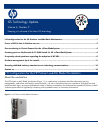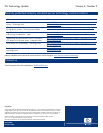
ISS Technology Update Volume 6, Number 9
6
Licensing ports on the Brocade 4/12 SAN Switch for HP c-Class BladeSystem
The Brocade 4/12 SAN Switch for HP c-Class BladeSystem is provided with 12 port licenses, two of which are pre-reserved for
external ports. This article focuses on port licensing as it relates to the many questions that HP representatives encounter at
technical events. Here are two such questions:
• Can more than 8 servers be licensed with each Brocade 4/12 SAN switch (Figure 4-1) at the expense of external ports (for
example, 10 server ports and 2 external ports)?
• Are there any rules determining which bay’s ports get licensed (for example, only servers in bays 1 through 8), or can one
manually assign licenses to any server port in the enclosure, regardless of bay number?
Figure 4-1. Brocade 4GB SAN switch*
* This illustration shows 4 SFPs. However, out-of-the-box the Brocade 4/12 SAN switch has 2 SFPs in the left-most slots.
We’ll share what we know about these licensing questions from both a practical field perspective and a product feature
vantage point.
Quick answers
In addressing the first question, the proposed scenario is permitted. The only requirement is to maintain at least one licensed
external port. However, if the configuration contains two HP c-Class Brocade 4/12 SAN Switches side-by-side in a dual path
configuration, the servers on the top of the enclosure should use Host Bus Adapter (HBA) port 1 and servers on the bottom
should use port 2. This will split the load between the two paths.
As for the second question, licenses are granted on a first-request basis; any of the 16 internal ports can request and be
granted a license. It is possible to turn off dynamic license allocation in the Fabric OS (FOS) and assign licenses manually if
desired, as described in the Command Line Interface (CLI) guide for Brocade FOS. Ultimately, licensing is not dependent on
bay numbers.
NOTE
If more than 11 servers are plugged into the Blade System, all the ports can be automatically
assigned to internal servers with no external connections.
About port management
In the past, Ports On Demand (POD) functionality was static. A preset group of ports was individually enabled per each POD
license. In contrast, the new Dynamic Ports On Demand (DPOD) feature does not require predefined port assignment. Port
assignment is determined by the discovery of active HBA ports, but is limited to the quantity of purchased ports.
















